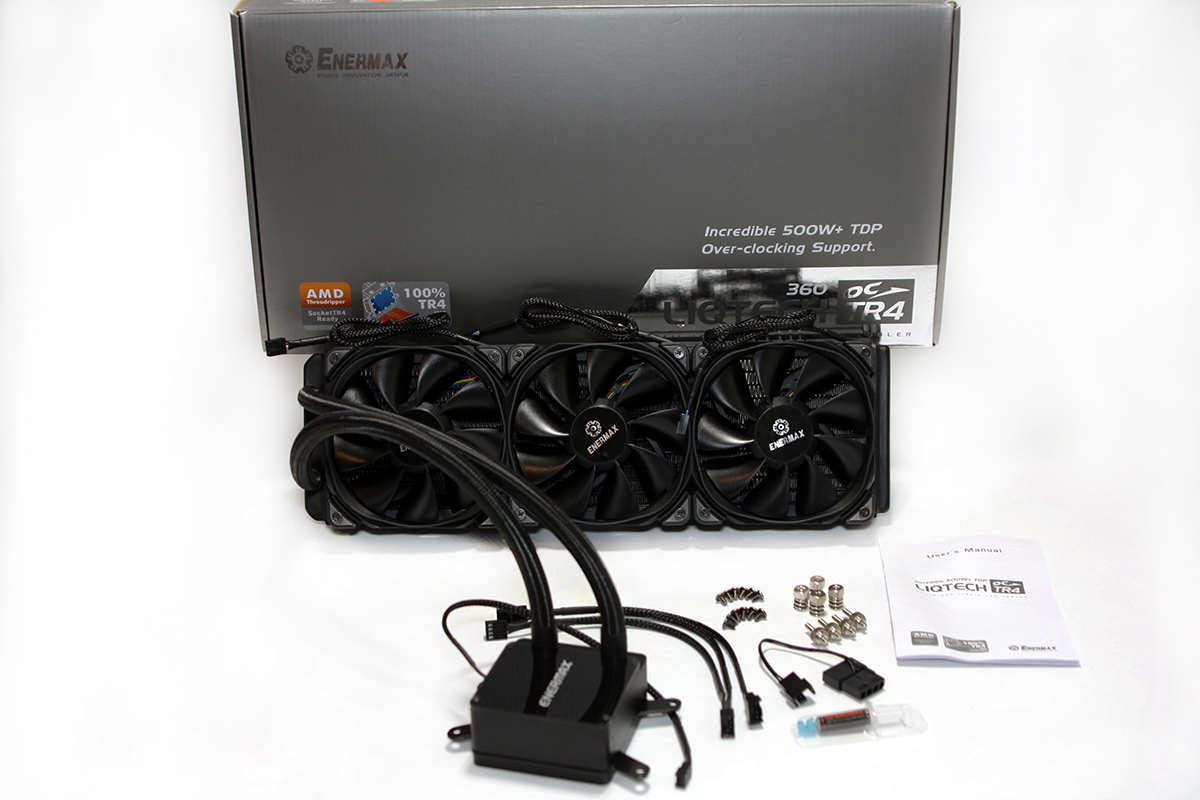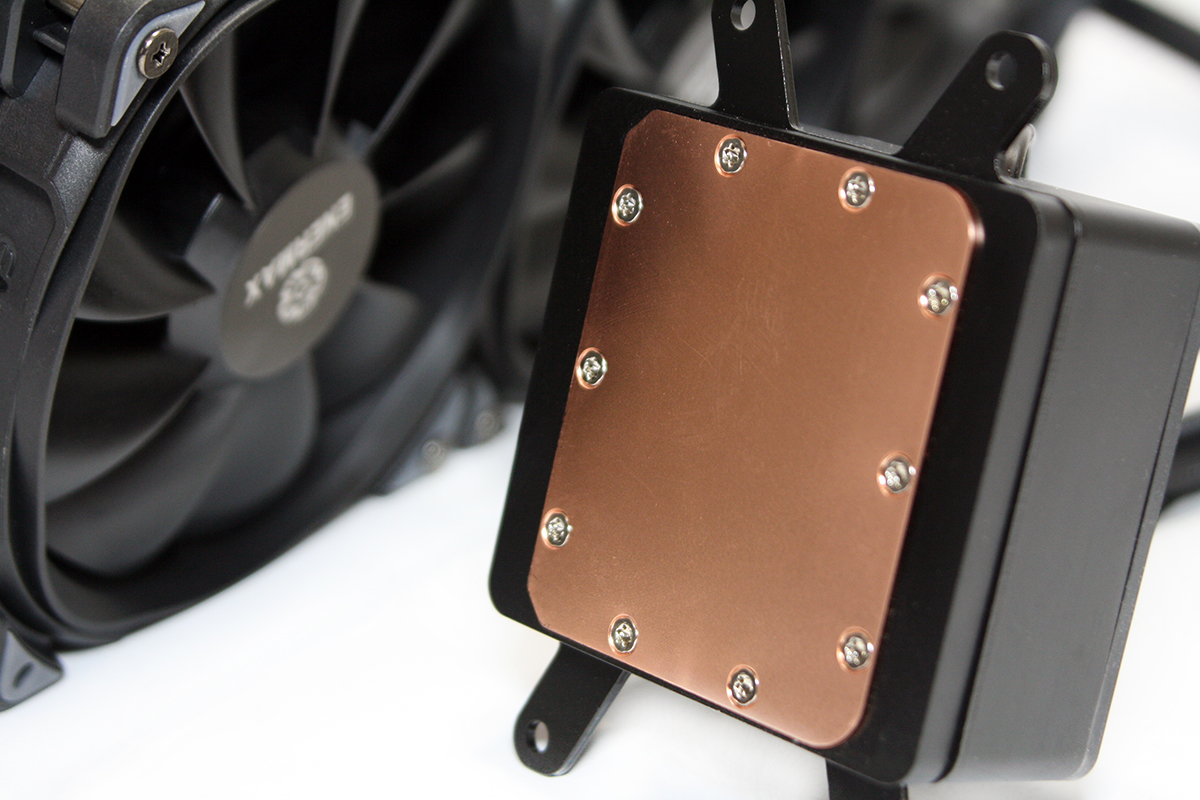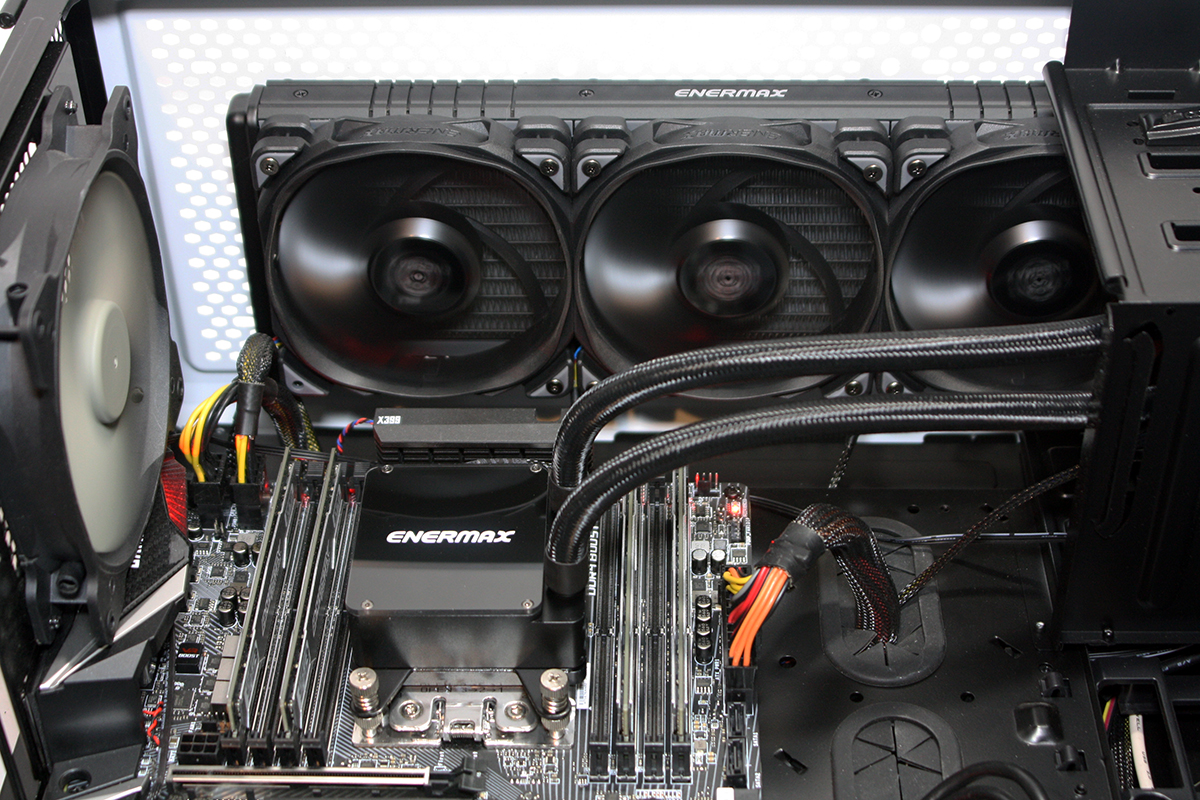Early Verdict
If you're after solid, cost-effective water-cooling for AMD's Threadripper chips, this Enermax solution delivers value and performance in equal measure.
Pros
- +
Excellent cooling performance
- +
Aggressive pricing
- +
Easy installation
- +
Full coverage of Threadripper CPUs
Cons
- -
No software UI for real-time management
- -
No RGB or LED lighting on fans (might be a plus, for some)
Why you can trust Tom's Hardware
Features & Specifications
AMD’s Ryzen Threadripper has already proven to be a revolutionary CPU socket. As a single-socket design with a CPU larger than any consumer die to date, Threadripper has mandated that manufacturers consider some new cooling approaches. The AMD TR4 package's core count, at this writing, ranges from an entry point of eight cores, with a 12-core option and up to 16 in the current flagship CPU, the Threadripper 1950X. While Intel has its current line of Core i9 "X-Series" products running from 10 to 18 cores themselves, the Threadripper processors have an integrated heat spreader nearly double the size of Intel's.
As you'd expect, a heat spreader this big presents some new cooling challenges. AMD Threadripper liquid-cooling options have been rather thin on the ground since the platform's debut in 2017, although we have seen more TR4-compatible coolers coming available in recent months.
Enermax has provided one such solution in the Liqtech 360 TR4 OC liquid cooler. Supporting only TR4 and SP3 sockets (the latter for the recent-model AMD Epyc server chips) simplifies the mounting hardware required for installation. Because swapping mounting brackets on the pump isn't necessary, installation will be less complex and tedious: no specific backplates, or determining which set of threaded mounting studs to use.
Along with the usual mounting hardware, Enermax includes a three-way PWM fan splitter to manage all three cooling fans via a single fan header. You also get a three-pin-to-ATA-style power adapter, if you wish to operate the pump at full speed (rather than using PWM from a motherboard header or fan controller). A small syringe of thermal compound also makes its way into the retail packaging, to help forestall those last-minute runs for paste.
As a 360mm AIO cooler, the Liqtech 360 makes use of a large 3x120mm aluminum radiator that provides a generous cooling field for the liquid-to-air heat exchange. The radiator itself comes with factory-applied rubber silencing strips along both sides to help minimize fan vibration and noise levels. Three 120mm Enermax Twister Bearing Pressure fans (25mm thick) are included to provide the airflow; they are advertised to spin at up to 2300 RPM.
The Liqtech 360 TR4 OC makes use of a broad copper contact plate that covers 100% of the integrated heat spreader (IHS) of AMD's SP3 and TR4 CPUs. The copper plate is milled nearly smooth and, while difficult to see from our photo, still maintains microscopic patterns from this process. The pump and contact block itself feel heavy versus the typical AIO-cooler pump/block unit. Whether this additional mass corresponds to copper being used for the cooling plate (or is attributable to a more powerful pump), we are uncertain.
The pump housing is primarily aluminum, with the top adorned with a cover plate of reflective black acrylic and secured at the corners with small star-head screws. The three-pin pump power lead is sleeved in braided black nylon and neatly covered at each end with heat-shrink tubing to prevent unraveling. The pump itself is rated for a 100,000-hour MTBF.
Get Tom's Hardware's best news and in-depth reviews, straight to your inbox.
When the cooling system is powered on, the Enermax logo shines brightly through the reflective acrylic, thanks to white LEDs within the housing. During our tests, the Liqtech 360 TR4 pump was run at full speed and registered an average of 3040 RPM on our equipment.
Given that the Liqtech 360 TR4 uses a large 360mm radiator, installation can be challenging in cases that have limited room in which to work, so make sure you plan accordingly. The benefits of supporting only the TR4 and SP3 socket are very clear during installation, as the mounting bracket aligns directly over the threaded stand-off studs, which are installed in the embedded mounting base of our MSI X399 Gaming Pro Carbon AC motherboard.
MORE: Best CPU Cooling
MORE: How To Choose A CPU Cooler
MORE: All Cooling Content

Garrett Carver is a contributor for Tom’s Hardware, primarily covering thermal compound comparisons and CPU cooling reviews; both air and liquid, including multiple variations of each.
-
dudmont I've run an enermax Liqtech cooler. No complaints about it. I was impressed by the fans that came with it. They're not to be underestimated.Reply -
Giroro "As a single-socket design with a CPU larger than any consumer die to date"Reply
You mean the largest heat-spreader, not the die. The dies inside of threadripper are the same 192 mm as the rest of Ryzen/Epyc - in a 4 die configuration where only 2 of the 4 dies are functional. -
peaceones What a poor review by THW with only the lowest end Threadripper for testing..Reply
Fortunately though I have 2 1950x configured with this 360mm AIO and the other a 240mm. The 360 runs at around 48C on full load and 240 at 51C. Thermal paste application has alot to do with TR4 temps and it looks like writer only put the standard grain rice amount. Check on youtube for the termal paste benchmarks -
Doctor Rob I also have one and it works great. THOUGH I WISH they had temp probs and other built into it like my other setup does.Reply -
rubix_1011 Reply20911364 said:What a poor review by THW with only the lowest end Threadripper for testing..
Fortunately though I have 2 1950x configured with this 360mm AIO and the other a 240mm. The 360 runs at around 48C on full load and 240 at 51C. Thermal paste application has alot to do with TR4 temps and it looks like writer only put the standard grain rice amount. Check on youtube for the termal paste benchmarks
An 'X' with small dots between is how paste was applied, although I'm not certain how 'grain of rice' was deduced without seeing the application since I don't recall writing about the TIM amount in detail.
It is great to see others having success with this cooler, also. -
jdball What's the difference between CPU Core and CPU PWM in the Temperatures over ambient graph? Also, does the temperature in the graphs exclude the ambient temperature e.g. if the ambient temperature is 25 degrees C then 51.4 is actually 76.4 degrees C?Reply -
rubix_1011 Temperature over ambient accounts for ambient room temperature, so yes, the display shows the difference.Reply
CPU core is reported core temperatures; PWM represents the motherboard's power delivery and voltage regulators which are cooled by the factory motherboard heatsink.





